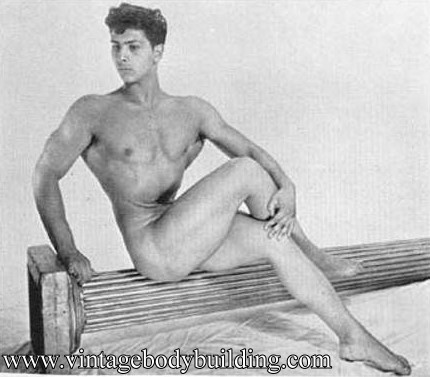
Physique photo blog
Joe Survilas from Art In Physique Photography

Hand Balancing
by Charles Atlas
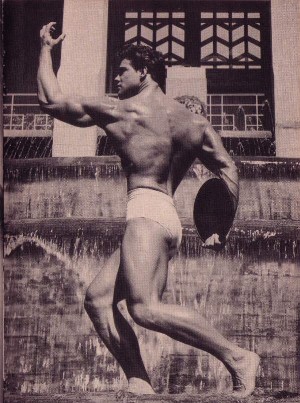
When one is learning a hand-stand it is necessary to have some sort of support in order to give the beginner confidence in himself. It is therefore advisable to begin by doing the handstand against the wall. Stay about two feet away from the wall. Put your hands flat on the floor, fingers spread apart, put all your weight forward and be sure to keep your elbows firm, and head up. Kick up with your feet resting them against the wall and arch your back. When you have held this position for a few seconds bring your feet away from the wall. The secret of the hand-stand is to keep your arms straight, your back arched and head up. Also keep the toes pointed legs together.
Follow the above instructions carefully and practice this everyday, I am confident you will be able to do a perfect hand-stand within a month. When practicing if you lose your balance fall to the side or to where you started from. Do NOT fall backwards as there may be a danger of hurting yourself.
When you are able to hold a perfect hand-stand for about ten seconds, try to dip down and up again. This is a marvelous exercise for both arms, shoulders and chest, also for the internal organs such as kidneys, stomach, etc. It relieves the strain on the muscles that hold the internal organs such as the stomach, bowels and liver. It is also very good for poor circulation.
When you become very sure of the two arm hand-stand so that you can stand on your hands as well as your feet you can try the one arm hand-stand. This is done by putting all your weight on one side holding the hand that is free out sidewards. The legs in the one arm hand-stand are spread apart so as to make balancing easier.
Do not be discouraged if you not successful the first few times you try these, but remember that perseverance is the key to success.
Young muscle sportsman Johny Clark
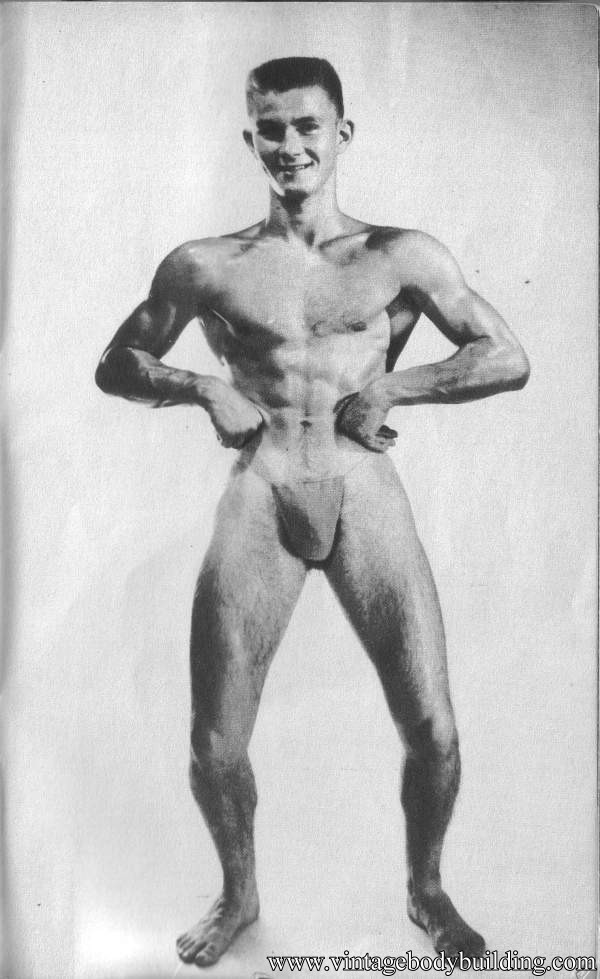
Yes, We DO Need Exercise!
YES, We DO Need Exercise!
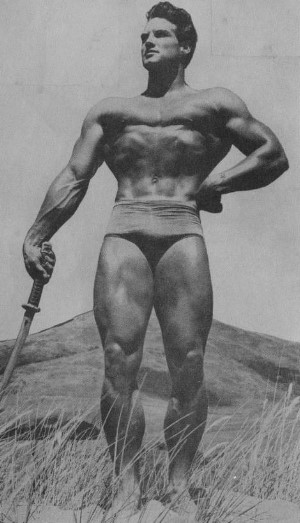 THE CASE FOR WEIGHT TRAINING got a shot in the arm recently in a comparative study oi’ the muscular strength and ability of American and European youths. Medical researchers in a major eastern university discovered that Americans are “getting soft” because of the relative ease of daily living, while Europeans with fewer of the “advantages” of modern life were stronger.
THE CASE FOR WEIGHT TRAINING got a shot in the arm recently in a comparative study oi’ the muscular strength and ability of American and European youths. Medical researchers in a major eastern university discovered that Americans are “getting soft” because of the relative ease of daily living, while Europeans with fewer of the “advantages” of modern life were stronger.
The cause of this sad effect has been laid to lack of exercise. No longer do we gel the once necessary exercise such as wood chopping, water pumping, and walking. Central heating, running water, and automobiles have done away with much of the exercise which once kept young Americans in shape.
In the test, young people in America and Europe were asked to perform a series of exercise routines. (One of the exercises was the Leg Raises demonstrated in the May VIM.) Almost 6 out of 10 American youths failed to pass this muscular fitness test . . . while more than 9 out of 10 of the Europeans passed it!
The American youth today may he taller and more handsome and more “vitamin-enriched,” hut lack of exercise has made him inferior to his rugged, hard working ancestors.
It is surprising to many, and alarming to Armed Forces officials that approximately one man out of every three examined by selective service during the Korean War was found unfit for military duty! (This startling fact does not reflect quite so dark a picture, however, since the figures do not cover the healthy young men who enlisted for duty.)
The situation seems to indicate a definite need for such a sport as bodybuilding through weight training, despite the propaganda from various camps that “exercise is for the birds” or that “muscles can he built in bed.” Protein, the much vaunted miracle food, may aid in muscle building, but it does not replace sweat and exercise.
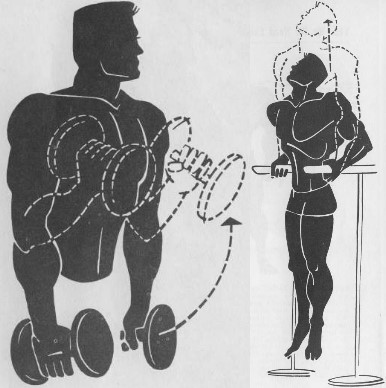
DUMB BELL CURLS are one of the best known, most used, and most effective of the arm exercises. The number of repetitions is probably more important than the weight used, so choose a set of bells you can handle with relative ease. Standing erect with your arms at sides as shown in solid figure, curl the weights to the shoulders, as indicated by dotted lines. The elbows do not move . . . keep them stationary as though they were the hubs of wheels and your forearms were spokes. Inhale as the bells are lowered, hold your breath as you raise the weights, 4nd exhale when weights reach shoulder.
PARALLEL BAR DIPS require no weights . . . except that furnished by your own body. The Dips consist of pressing your body upward between the bars until your arms are straight . . . and lowering it as far as possible. Bars should be about shoulder width apart. Inhale as you lower your body, getting a full breath by the time you reach your lowest point, and then . . . (don’t hesitate) press right back up, holding your breath as your body goes up. Pause slightly and exhale completely when you’re at the topmost position. Keep your chest out, head back throughout the exercise.

DUMB BELL SIDE RAISES are a popular deltoid exercise. (Deltoids, you know, are the impressive mound-like muscles which cap the shoulders.) Standing with your feet about a foot apart and holding the dumb bells in front of your thighs, as shown in the solid figure, raise both your arms outward and upward until you reach the “spread eagle” position shown by the dotted lines. (The knuckles are pointed forward for this exercise.) Pause briefly, exhale, and then lower the weights to their thigh-front positions, inhaling as your arms go downward. Don’t take a rest when the weights are at their lowest point. Instead, raise the dumb bells immediately. Here again, the number of repetitions is more important than the weight used. Don’t try to be a gym hero by grabbing the heaviest weight you can find. Start with a moderate, easily handled weight, and work up.
The Argonauts, Volume 1 № 1 by Physique Press.
American Physique Questions And Answers
Questions And Answers from American Physique Volume 1 № 1
**********************
 1. Ques. Does a man have to keep on training for the rest of his life to keep his physique ?
1. Ques. Does a man have to keep on training for the rest of his life to keep his physique ?
Answer — Not necessarily, meaning that a man does not have to follow a routine as strict as the one he was following, to build up his physique. But I do recommend at least one exercise for each part of the body at least once or twice a week about 10 times each exercise to keep body in shape.
2. Ques. How long must a man train before he has a good enough physique to enter contests or take physique shots for magazines ?
Answer – The first year of your training is the foundation of the physique. From then on each individual will improve in a different manner; some will make terrific gains in the next 6 months, some in the next year. If you or anyone else has at least 3 to 5 years of good, earnest training, then it would be to your advantage to enter a contest and can rate quite high. As for physique shots in magazines you can send them in at any time since we use case histories of beginners and their improvements.
3. Ques. I have been training to loose weight around the mid-section but instead I got a heavier appetite and I keep on gaining weight. What do you suggest I should do ?
Answer — I suggest that if you have an increase on your appetite don’t be afraid to eat. “But” do not eat to much starches, sweets or ice cream, that’s what puts on weight. In your training routine try a higher amount of movements and also try doing some abdominal raises and leg raises before going to bed at night and if possible in the morning also.
4. Ques. I am a slim fellow, I have been training for one year with light weights. And all I have to show for it is slim muscularity. What can I do to gain some bulk?
Answer — In my opinion, I find that you have already built the foundation of your physique even though you did not train correctly for bulk. In the next year try a lower amount of repetitions about 10 and heavier weights for bulk.
5. Ques. How does a man go about becoming a weight-lifter or body builder ?
Answer — If the man does not have a set of weights he should try and get himself a set since he can receive Instructions on Bodybuilding or Weightlifting which explain how to start off in these sports. Or there are Y.M.C.A.’-s and many Gymnasiums which have instructors and weights. If at anytime some problems should arise there are always consulting editors from physique and lifting magazines who will be willing to help if possible.
6. Ques. Can a person get ruptured from lifting weights ?
Answer – Yes, if the person tries to lift more than he can handle. And also if the weight is not lifted properly.
7. Ques. Who was Mr. America of 1943 ?
Answer — Jules Bacon, who has a wonderful physique until this day.
8. Ques. How can I increase extra poundages on my lifts ?
Answer — Try less repetitions with more weights until you reach the amount of repetitions you were doing in your training. Then start over again.
9. Ques. I do heavy work during the day. When I come home at night I’m very tired and can not get enough energy to take a workout. Is there a program a fellow in my position can follow ?
Answer — If you try lying down and relaxing for about one hour then take some honey (about 1 tablespoon); this will give you quick energy. Also to rest a little longer between exercises might be helpful.
10. Ques. Can you straighten me out on the difference between the Biceps Femorus and the Biceps ?
Answer — The Biceps Femorus is the back of the upper leg which controls the bending of the lower leg while the Biceps is the upper arm which controls the bending of the lower arm.
American Physique is dedicated towards a peaceful world. May it be of some small help in granting serenity to accept the things we cannot change, the courage to change the things we can and wisdom to know the difference.
American Physique – a masterpiece of beauty in manly arts.
Health Hints For Bodybuilders
Health Hints
by Dr Frederick Tilney

Here’s the proven, effective, natural way to avoid having any “colds”, coughs catarrh, bronchitis and these so called “winter time” ailments which handicap millions of folks this season of the year. Understand, first of all, none of these annoying conditions are caused by “germs”. And realize this, you are not helping yourself by taking any “cough syrups”, lozenges, serums or medicines for these troubles, nor will nasal sprays be of any real practical value. You have surely tried these things before and discovered for yourself that they don’t work.
I’ve said so often and repeat again., you must tackle these troubles at the source. Its the wrong foods, plus a serious food mineral .deficiency which brings on these colds, coughs etc. Briefly, “colds” and allied ailments are nothing but an accumulation of mucus or phlegm working out of the system, through the nose or month. Germs do not cause mucus. Mucus-forming foods create it, and when there is an excess, it has to be expelled and the cold weather plus the wearing of heavy clothing, living in unnaturally heated buildings drives this mucus out — which you experience in the form of a “cold” cough, catarrh, bronchitis etc — and if seriously neglected develops into pneumonia, pleurisy and finally because the system is so congested with mucus, death is the result.
The logical thing to do is to stop eating these mucus-forming foods. The average person has the idea that because the weather Is cold they must eat more “energy-giving”, “heat – forming” foods and so they use more fats, grease, starches and sugar, cow-milk, syrups — but unfortunately these are all mucus forming and CAUSE the “colds”.
Millions of mothers wonder why their children have the sniffles, whooping cough, runny noses, tonsil trouble, adenoids. so irritable by being all “plugged up”…..this comes from giving porridge (or oatmeal) with sugar milk or cream. The combination MAKES mucus or “colds”. Leave the breakfast cereals alone which are made from white rice (whether dry or cooked cereals, it makes no difference). Avoid them. They are NOT “nutritious” foods at all.
My practical suggestion is to AVOID eating all products made WITH white flour, white rice, ordinary oatmeal, white sugar, white salt, egg “whites”, all fried fatty, greasy foods and an excess of cow’s milk in its various forms. They are all food-mineral deficient and the CAUSE OF ALL THE TROUBLE. Don’t eat them and you will avoid “colds”.
In many homes, these items often form much of the bulk of the foods eaten, no wonder they are continually suffering. Stop the cause at its source. Any treatment you take is almost valueless UNLESS you ALSO stop eating these products which CAUSE the trouble. You do not “catch” colds from anybody, or from others in your family. You merely ate an excess of mucus forming foods, which has to come out. and does so. in the form of mucus from i he nose or throat.
If you want your “heating” and energy-giving” foods use those which do not CREATE mucus. Try using dates. black mission figs, raisins with raw nuts well chewed (which are natural lats). Use honey, moderately in place of white sugar Use fresh or unsweetened canned juices in place of so much cow-milk which has been greatly over-rated. Goat Milk (capsules) should be used generously as this is not mucus forming, are richer in all vitamins and food minerals than cow milk. When cereals are craved, use the whole wheat only. Go to your “Feed Store” and buy 10 lbs of wheat kernels. Wash what you need for a meal and then let soak in water overnight, eat with raisins and little honey. Its simple, nourishing, delicious, good; saves a lot of cooking. Victims of colds, coughs, catarrh are seriously deficient in the Food Minerals Phosphorous, Iron, Silicon, Chlorin. These are easily obtainable in capsule form, prepared solely from various powdered vegetables. Try them. Thousands of folks have proven the value of these suggestions.
Your Physique, Volume 3 № 1, Mar 1943
Physical culture in Norway
by Rudolf Ness
RUDOLF NESS is Norway’s most prominent advocate of the weight-training way of life, and author of the internationally famous book, “Kruppskultur”.
Scandinavians in general and the Norwegian people in particular, are very outdoor-minded. Any fine week-end sees a mass trek from the towns out into the country, up into the mountains or to the coast and fjords; and in many instances, even working-class people have their own sporting huts where they can enjoy their free hours and vacations. Norway, land of mountains and woods, is not densely populated and there is ample space and privacy for all.
At Easter, the Norwegians take a week’s holiday and during this period vast numbers of people spend their time close to nature in huts, farms and special hotels in company with the British, Danish and Swedish folk who come to Norway at this time to ski and enjoy the wonderful scenic beauty. If the sun is kind — and it usually is — it is a grand company of dark-skinned individuals which returns to work at the end of the vacation.
In the winter-time, there are often opportunities for long trips on skis; unlike the Swiss, the Norwegians often prefer day-long tours on skis to the shorter downhill races common in the Alps.
The man-in-the-street is very sport-minded too. In summer, his interest lies chiefly in soccer, track and field events and sailing tournaments (these latter afford him the chance of a dip in fjord or sea). In winter, speed-skating and especially ski-jumping and downhill races are tremendously popular. Contestants fight it out over four distances in speed-skating, the best man over all four being declared the winner, and this is often very thrilling to watch. We have recently had the pleasure of a visit from Jack Cronshey who, quite unknown to a great part of the British public, has become one of the world’s best long distance speed-skaters. He has learnt good Norwegian, an international skating language.
Ski-jumping has a large following, and Mr. Average Man is very knowledgeable about the sport. The principal event in this country is the international Holmen-Kollenplays, held every year, in March, near Oslo, the Capital. Here the world’s best skiers foregather and it is not unusual for 100,000 spectators to be present at the special jumping event. After Holrnenkollen, the Swedes hold their own Sollefteaplays and the Finns their famous Lahtiplays. Denmark, where snow seldom lies for any length of time, also has its Holtekollen ski-jumping event on a hill near Copenhagen, in which Scandinavia’s best ski-jumpers take part. But suppose there is no snow, you ask? Well, the answer is simple, it is sent by train from Kongsberg, famous Norwegian town of ski-jumpers! !
Little publicity is given to weight-lifting as a sport in Norway and the Norwegian Weight-lifters’ Association works under difficult conditions. The sporting journalists are not very interested in what they regard as a minor sport.
The average Scandinavian has little interest in body-building, he is a great believer in outdoor life and admires character immensely, but the promotion of male physique contests would only arouse ridicule.
To introduce weight-training and body-building to Scandinavia, it is necessary to stress the benefits of heavy exercise for better health and for better results at work and in sports other than the “Iron Game” itself.
Nine months before the Olympic Games were scheduled to take place, we had a good 8-oar team. Birger E. Larsen, a Bergen athletic coach, and myself believed that the introduction of weights in their training programme would help enormously and to this end the boys were trained intensively, much attention being given to make them quick as well as very strong. At Henley, that Norwegian team placed third to U.S.A. and Britain in the eighth race. This was a great surprise to most Norwegians as they have little belief in the value of weight-training. I shudder to think what would have been said had the experiment failed to justify itself. This medal award in the Games meant that our form of training received a little more publicity.
Sverre Farstad, Olympic 1,500 metres ski-jumping champion and European champion, 1949, is also a weight-lifter and endorses the use of ” iron” as an aid to athletes in other sports. Farstad has equalled the world record of 41.8 seconds for 500 metres speed-skating … and they say weight-training makes a man slow!
Here in the Bergen district of Western Norway, the hard struggle to obtain recognition of the benefits of weight-training when allied to specialised sports is at last bearing fruit, and new ground is being steadily gained. The leading coaches are firm in their belief in the use of ” Iron ” in the basic training for a large variety of sports. Unfortunately, weights are costly and with up to 50 men training at a club at one time, the difficulties can be well understood. However, by implementing what weights are available with heavy sandbags, good results are being achieved.
A specimen programme commences with free exercises, limbering-up movements, indoor running, etc. Following this comes up to one hour’s exercise with such apparatus as Roman rings, parallel bars, the horse (for quickness) plus, of course, sandbags and weights. For the latter, the class works in two sections, No. 1 with dumb-bells and barbells for the heavy body-building exercises, No. 2 with quick weight-lifting movements and abdominal boards. For the final phase the trainees plav very fast basket-ball or handball, using one or two large medicine balls.
All athletes can benefit immensely from a regular weight-training, bodybuilding course, adapting this to their specialized needs. The use of many quick movements, with and without weights, will give the man who practises them a tremendous advantage over his rivals who decry these methods. Examples of quick exercises without weights are sprints, quick gymnastic movements, badminton, table-tennis and fencing. For weight exercises, the use of sandbags and the incorporation of the fast lifts into a training programme can be of great help. Use moderate weights to begin with. Speed and yet more speed is vitally important in many sports. It is very often the last stretch which decides the winner of a race and it is the man who possesses speed and strength who will emerge the victor.
If you want to be in the top flight, you must train and train. Some journalists have created the impression that sport is baby play and play again. But you will never reach an international standard by merely playing around. It docs not necessarily mean that you must put in more training time than ever before, but the intensity of the effort must be greater. When people see a runner like Harrison Dillard they are apt to say “How easy the whole thing looks, just like play”. But they overlook the tremendous amount of hard training which Dillard has put in to achieve his magnificent victories. Far too many athletes fail to appreciate the necessity for that extra little effort which is the margin between success and failure.
Whatever your favourite sport, remember the words of Henry Atkin: “To become a champion to-day it is necessary to train hard, often and, in special sports demanding much power, with really heavy weights.”
Body Culture, Volume 1 Number 2, September 1949
Bodybuilder vintage photo art
